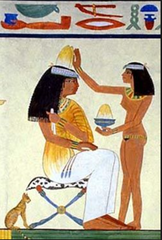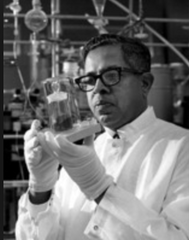Aromatherapy
History of Aromatherapy
The term aromatherapy is a relatively new term, having been coined in the 1930s to describe the aromatic nature of many of the plant remedies available. However, the use of plant remedies is as old as civilisation itself. In the ancient world, Egypt was famous for its use of aromatic substances for medicine, cosmetics and perfumery. One recipe for a cosmetic face pack was: Incense ball (myrrh and/or frankincense), Wax, Fresh oil, Cypress and berries
This was all to be crushed and mixed with fresh milk to apply to the face for six days.
Myrrh, being an excellent anti-inflammatory, was also listed in a preparation they had for eye inflammation. The antiseptic properties of myrrh, cedarwood and other aromatics was well demonstrated in their use in the mummification process.

One of the Egyptian’s most famous perfumes was Kyphi which included a mixture of calamus, acacia, cassia, cinnamon, peppermint, citronella, pistacia, henna, juniper berries, raisins, cypress, different wines, frankincense and myrrh. It was said to “lull one to sleep, allay anxieties and brighten one’s dreams”.
The ancient Greeks learned well from the Egyptians. The 4th century BC Herodotus declared them to be masters of perfumery. The Greek physician Theophrastus made detailed recordings of the aromatic plants to be used. He wrote “it is to be expected that perfumes should have medicinal properties in view of the virtues of their spices … since they dispersed tumours and abscesses and produce a distinct effect on the body and its interior parts.” Hippocrates, from whom originated the doctor’s Hippocratic Oath, was a holistic healer who developed a theory of four humours. Plants associated with each humour were used to restore balance to body so it could repair itself with its own natural healing powers. (This is similar in nature to the approach taken by Chinese medicine which recognises five elements).

With the coming of the Roman empire, the use of these unguents continued in lavish fashion, anointing their hair, bodies, clothes, beds, even flags and the walls of their houses. (Anointing the body is still popular in modern day cultures such as Africa and Tahiti where women oil their hair after washing with a mix of coconut oil scented with sandalwood or toromeo root.)

Ovid, the enormously popular “poet of love” and contemporary of Caesar Augustus, wrote a book on cosmetics (of which only fragments remain), Medicamina Faciei. In this, he recommends frankincense “as suitable for humans as it is agreeable for the divine”.
In the first century AD Diascorides wrote a text on herbal medicine which remained a medical reference work 1000 years after his death. Many of his remedies are still used today in Aromatherapy. It was only in the tenth century that a major new advance in the form of distillation was perfected by Avicienna of Arabia, of whom the rose was a particular favourite. This discovery was transported to Europe in time and taken up by the French perfumers.
Such knowledge was not restricted to these cultures. In India and China, whole systems of herbal medicine were developed over the centuries. The classic Indian texts, the Ayurvedas, contemporary to the Egyptian developments, contained a great number of preparations using aromatics.
During the 14th century, the Black Death plague swept through Europe killing millions of people. Herbal preparations were used extensively to help fight this terrible killer which had a mortality rate of 50 to nearly 100% depending on the form and stages it reached. Even in the 20th century, conditions in some parts of the world have allowed the very deadly Yersinia pestis to cause a further outbreak of bubonic plague. It is believed that some perfumers in the 14th century pandemics may have avoided the plague through constant contact with the natural aromatics. The plague doctors, highly valued physicians who specialised in treating this horrible disease, used a mask filled with aromatic spices to help reduce the likelihood of contracting the deadly disease.

It was very clear that in the 14th to 16th centuries, aromatic oils were becoming popular in massages used to treat internal disorders. During the 15th century, more essential oils were distilled including frankincense, juniper, rose, sage and rosemary. It wasn’t long before the number of books started to expand. Paracelsus, an alchemist, medical doctor and radical thinker is credited with coining the term Essence. As well as being a founding father in the area of toxicology, his studies further highlighted the use of plants as medicines. By the 17th century, people like Culpepper, Parkinson and Gerard brought a golden age of herbalism to England. As with any successful medicines, there also came much unscrupulous charlatanism which tended to devalue the discerned benefits.
In the 19th and 20th centuries, great advances have been made in medical science. While there was a general turning towards chemical synthesis of “active ingredients” rather than use of whole plant or plant essences, there has been a considerable amount of research into the powers of the essential oils.
In the late 19th century, the perfumery industry was growing rapidly and drew almost entirely on natural essences. As it grew, new applications for these essences were sought. René-Maurice Gattefossé was one such chemist who, like his brothers, joined his successful family business producing and using essential oils and other materials for perfumes and other drug store products. Working with his brothers, René began to learn of the powerful antiseptic properties of many of the essential oils. This was further augmented when, working in his lab on the day his son Henri-Marcel was born, an explosion plastered him with burning materials which he writes, "I extinguished by rolling on a grassy lawn, both my hands were covered with a rapidly developing gas gangrene. Just one rinse with lavender essence stopped the ‘gasification of the tissue’. This treatment was followed by profuse sweating and healing began the next day.” Gattefossé’s Aromatherapy, 1937

He worked closely with researchers in hospitals and universities around the world developing pharmaceuticals as well as cosmetics and personal care products. His fascination with essential oils inspired him to experiment with them during the First World War on soldiers in the military hospitals. He used oils of lavender, thyme, lemon and clove for their antiseptic properties. Gattefosse noted an increase in the rate of healing in wounds treated with essential oils and that the oils seemed to be free from the disadvantages present with other antiseptic agents in use at that time. He writes “French cosmetic chemists are concerned that the natural complexes should be utilised as complete building blocks without being broken up. Dermatological therapy would thus develop into “Aromatherapy”, or a therapy employing aromatics in a sphere of research opening enormous vistas to those who have started exploring it”.
Gattefossé’s approach was atypical of his chemist contemporaries but this was driven by his own experimentation which showed that the whole essential oil was actually more effective than the individual components: ‘The whole is greater than the sum of its parts’. In 1938, Gattefossé reported the results of a friend and colleague, Godissart, who set up an aromatherapy clinic in Los Angeles in which he treated skin cancer, gangrene and osteomalacia, stubborn wounds, facial ulcers and Black Widow spider bites (lavender neutralises the spider’s neurotoxin). Unfortunately, the advent of World War II considerably dampened interest in researching these new areas. However, the later research work of the medical doctor Jean Valnet has re-established the importance of aromatherapy as a therapy in its own right. He writes, "Essential oils are especially valuable as antiseptics because of their aggression towards microbial germs and their harmlessness to tissue -- one of the chief defects of chemical antiseptics is that they are likely to be as harmful to the cells fo the organisms as to the cause of the disease." Extension of the very medicinal oriented use of aromatherapy into the beauty therapy arena was championed by another French compatriot, Marguerite Maury, a biochemist and beautician. Maury paid particular attention to the external application of essential oils diluted in vegetable oils with massage to provide therapeutic benefit to the client.
Perhaps lacking until more recent times has been carefully conducted objective clinical studies. However, there appears to be a growing and healthy interest in researching the use of essential oils in academic institutions as yet more is discovered in regards to their effectiveness in treating a wide range of conditions.
(In writing this brief history of Aromatherapy, we acknowledge the use of Robert Tisserand’s classic, The Art of Aromatherapy, Salvtore Battaglia's The Complete Guide to Aromatherapy, Wikipedia and other internet resources).
Why We Use Aromatherapy
Aromatherapy is not a new discipline but unfortunately in our synthetic chemistry oriented age it has often been an overlooked one. Fortunately, this is changing and there is a renewed interest in this ancient discipline. The use of Aromatherapy aligns well with our core values which include our belief that the natural world our Creator made for us already has the recipes for good health if we choose to study them close enough. We have the benefit of centuries of work in this area and we ignore this research at our own peril. In this scientific age, new advances have enabled us to engage with novel and often very successful treatments. However, there is also a dark side. In our food chain we are exposed to genetically modified crops and some companies are even genetically engineering seeds to prevent those plants reseeding (presumably so the manufacturers can control sales and distribution and ultimately, food supplies). We consume modified soy and trans fats, synthetic flavours and colouring and our drugs can have quite horrendous side effects. With all these invasions, it is not surprising to find that large population segments seem to be suffering chronic degradations in health.The pendulum is swinging back as people are more and more turning back to natural products. There is now a large accumulated body of knowledge available to us with further excellent ongoing research being conducted (such as treatment of cancer with essential oils) and it is this body of knowledge we draw on in formulating our own products.
